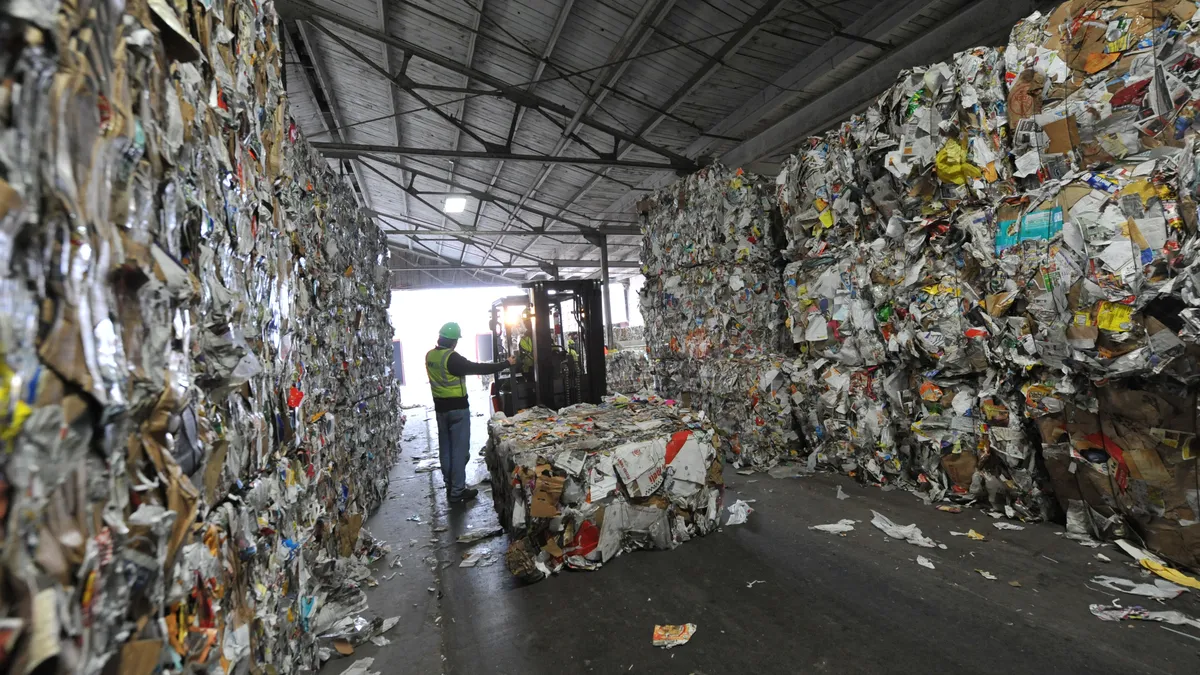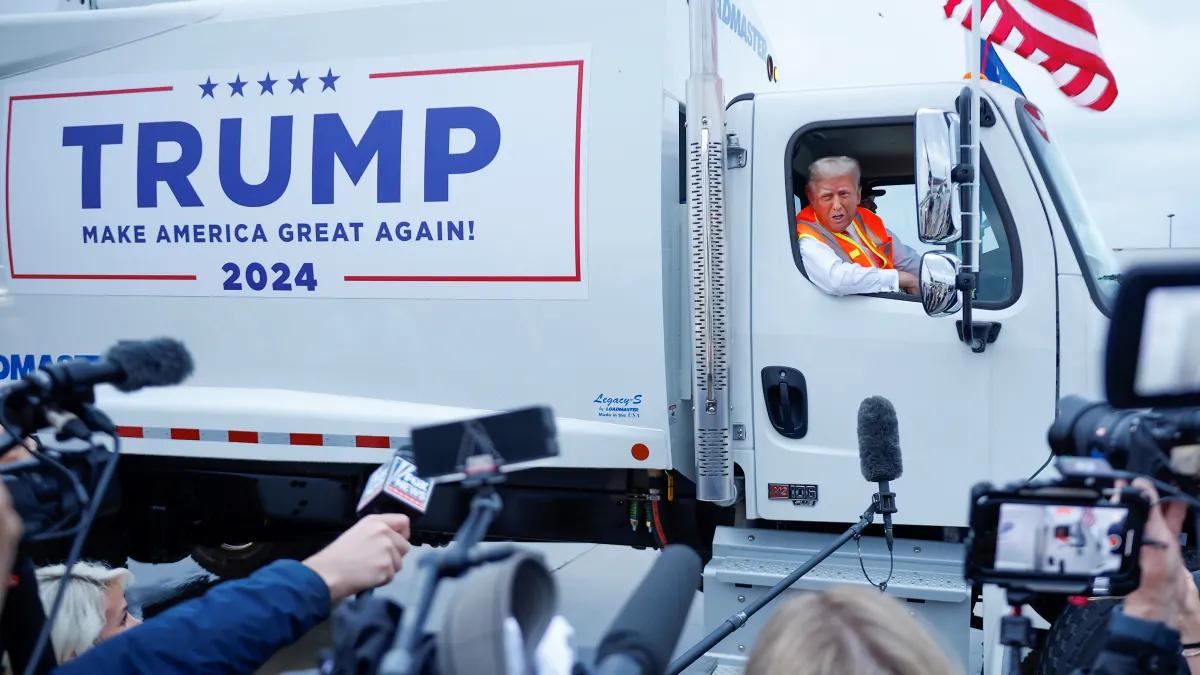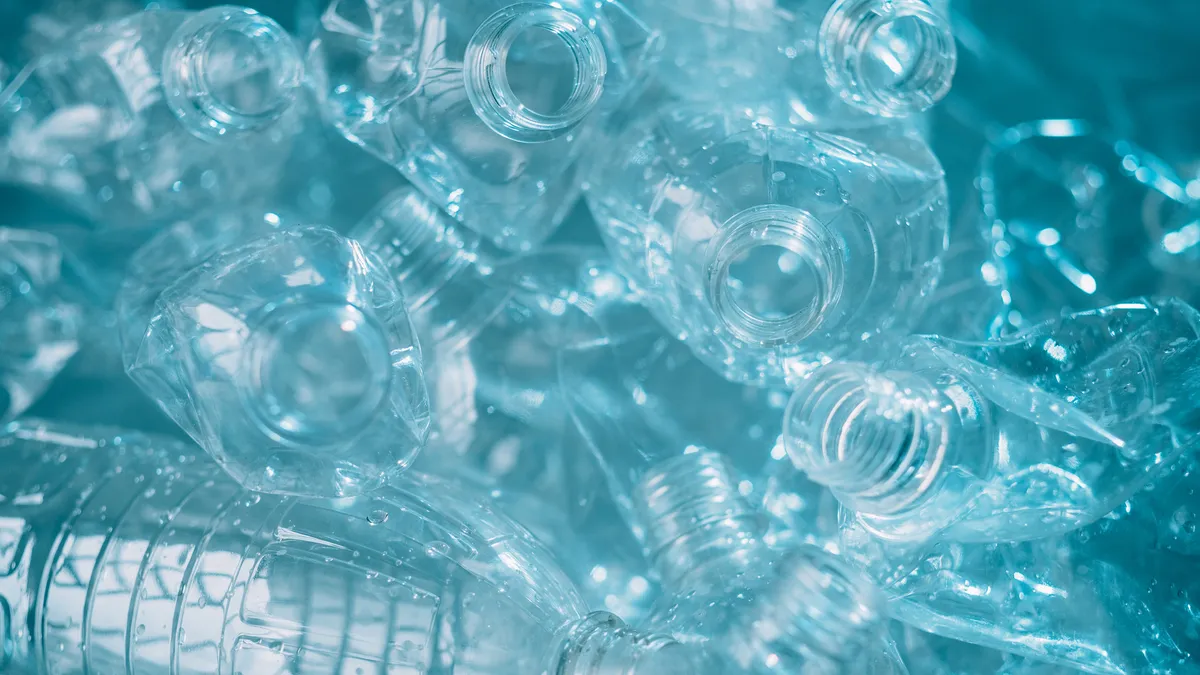Long before Chinese import policies altered the economics of recycling, Waste Management was among the leading voices questioning the environmental benefits of focusing on broader diversion goals rather than specific materials with the best emissions reduction potential.
Federal Public Affairs Director Susan Robinson is a familiar presence in such discussions around packaging, as well as food waste, broader industry standards and plenty of other policy topics. At a moment when the conversation about education and cross-industry collaboration has been reinvigorated, Waste Management could be a key voice in the years ahead.
Having worked with the company for nearly 20 years in a host of areas, Robinson can be expected to play a sizable role in whatever comes next for the company's public policy strategy. Waste Dive caught up with her to get the latest outlook on what that will look like in the months and years ahead.
The following interview has been edited for brevity and annotated for context.
WASTE DIVE: Waste Management seems to have made a conscious choice to be more publicly involved in the packaging discussion than others by working with Ameripen, Sustainable Packaging Coalition, The Recycling Partnership, and various groups. Why is that important to the company, and how did you decide to get involved?
SUSAN ROBINSON: I'd say it started out a good five years ago, as we started to be aware of the changes in the waste stream ... With the decline of newspaper, really most of what was left in the waste stream was packaging. And I don't think we'd ever thought about it in that context before in our industry.
As the largest recycler in North America, we really needed to understand that dynamic, both from the awareness of the change that was happening, as well as then playing a role in helping to educate those folks producing that packaging as to what made it recyclable through our entire system. So we really started a campaign about five years ago with the different aspects of what makes something recyclable from the collection, the processing, as well as the end market.
Did this align with Operation Green Fence or was that just a coincidence of timing?
ROBINSON: I'd say loosely. We started to be aware of it probably a little before, but Operation Green Fence really magnified the issue and I think kind of forced us to really dive in full force and really become engaged.
Among her many roles, Robinson is a co-chair for the currently in development Solid Waste Environmental Excellence Protocol's steering committee. In June 2017, she wrote about the concept of "material push" versus "demand pull," and the challenge in aligning public health goals of local city staff with the sustainability branding goals of manufacturers.
Five years in, do you feel like packaging companies are learning more about the recycling industry's perspective? We all know it's still kind of a challenge to make that balance between push and pull line up. Is the conversation getting easier at least?
ROBINSON: I think we're having it more often, and we're having it as a constructive dialogue throughout the whole value chain. I think we've learned a lot around the fact that the industry is just changing so fast.
As you quoted, and I heard Rob Kaplan say at the [U.S. Food Waste Summit], packaging is going to continue to get more complex. So what are we going to do about that? We need to all work together to figure out how we are going to manage a very complex package coming through the system.
Another "aha" moment that I think we had to come to terms with is the reality of curbside collection. When you add a type of material to a curbside collection program, it becomes an inelastic supply and demand relationship. You have no ability to turn it off once you turn it on. Even when the demand declines, we continue to collect the same amount of material every day and that is something I don't think we understood as an economic relationship previously.
Robinson goes on to discuss the need for more domestic markets, citing Waste Management's push to keep plastic domestic as mentioned by the company's head of recycling in a March interview.
This ties into comments made by CEO Jim Fish during a May interview when asked about whether the company's move away from encouraging "diversion" at any cost would mean a change in policy with cities that have set ambitious "zero waste" or recycling rate targets. Since then, the company has begun asking more cities to renegotiate current contract terms to reflect higher costs.
Everyone is having to reevaluate this new landscape we're in. For the cities that are striving to hit those high targets, are you finding that they're willing to pay more to keep going so far?
ROBINSON: I think we're early in the process. Folks in the industry are really happy to have conversations with customers around what's happening in the market, and certainly nobody wants surprises down the road.
We have certainly seen different communities across the country react very differently, and not just our customers. You certainly have seen some places that have really, early on, struggled with how to move material. Some are choosing to continue to collect the material when they can't find markets for it, some are going to be choosing to pay more to perhaps move material at a greater cost.
We find different communities will approach it differently depending on really what their priorities are. That is something I think about a lot. I think this is another opportunity for us to work with local communities to really, I hope, help them understand the value that recycling has to their community and really step to the plate to ensure sustainable programs.
So far the larger cities, some of which aren't your customers, appear to be plugging ahead no matter the cost. It seems like the small and medium-sized municipalities have taken more of a hit so far. Florida's Broward County comes to mind as an area where some have experienced a bit of sticker shock. If they say new rates are too expensive, do you also make the environmental case to them in addition to the need for a fair return on investment, or is that something they need to decide on their own?
ROBINSON: I think we're going to see more of that. Over the next year, you're going to see cities really posed with decisions. And one of the things that we hope to do is to talk to them about those materials that do make the best environmental sense.
Robinson goes on to describe the company's two-year "Spectrum" research project that performed an environmental and economic analysis of opportunities in the U.S. recycling stream. The company's conclusion was that 84% of greenhouse gas emissions reduction could be achieved by focusing on about 32% of the waste stream — essentially bottles, cans and paper.
So we think if we can help folks understand that cost benefit/environmental analysis, we may be able to help them kind of come to a place that works for them, keeps their costs in line, but helps them also with their environmental benefits.
If Waste Management, and many other companies and local governments, are focusing on this core group of materials and making the case in terms of emissions and cost efficiency, that still leaves a lot of other stuff out there. The companies making the case want to say it's recyclable. Maybe they've met the Federal Trade Commission's 60% threshold to make that claim. What happens to all of that other material, and how much of it is Waste Management's responsibility to figure out?
ROBINSON: This is where I put on my hat of kind of short-term long-term, and trying to be pragmatic. So perhaps in the short term, we need to focus on those basics. But I think we also need to recognize, as you say, there's a big world out there. There are a lot of different types of materials out there and a lot of demand on how we manage that material. I think technology's going to have to play a really important role ... It's an important solution for our industry. Whether it's sorting technology, whether it's different processing innovations or different packaging design. We really need to pull all of our technology levers and to be able to create that sustainable recycling future.
The key for us is kind of the timing of it. We need to make sure that we're not hampering the cost-effectiveness of our programs and burdening our local communities too early, but that we develop those technologies and get those really operating well and understand end markets. That's such an important piece. We, I don't think, have ever focused enough on the strength of those end markets so that we can pull that material through.
My perception is circularity is this great visual for keeping things in motion, but you can't sacrifice the environmental or economic benefits overall for just one particular type of material. You need to really look at the lifecycle analysis in the short-term. And if you do that, eventually, as we start to follow through on these materials, we can keep that long-term circularity in mind.
This also raises a question I've been asking everybody in some form for the past few months. Who do you look to as the arbiter of that conversation? When we have this decentralized structure, and there's no national policy, and there are a lot of players throwing new material in there and making claims about recyclability, and there are so many voluntary groups organized to address it, how do we push things forward in a meaningful way?
ROBINSON: I think that's why we are engaged in the dialogue. I think that's why you see so many stakeholders engaged in the dialogue.
That's a big difference between the United States and other countries, and I think it's going to be an evolution of thinking over time ... Our business is very local and that is part of the way our country works, I'm not sure that's going to change, but I do think that we're starting to see some states look at things from a more harmonized perspective.
Robinson cites recent efforts to standardize material lists in states such as Massachusetts and Washington. Connecticut and Florida have also taken similar steps within the past year, and discussions are ongoing in other states too.
You're starting to see some states engage in this dialogue and so I think it's going to just evolve over time. I think about this a lot. Nothing's going to happen tomorrow, we are a complex industry.
Right now the recycling conversation is very much cost-based and it seems to be dominating where we are. Though Waste Management has also continued to emphasize the sustainable materials management perspective. Do you think we can get back to that any time soon, or will the national conversation continue to be all about cost for the next few years?
ROBINSON: I think we will be continuing to focus on cost ... We are not going to turn back from the recognition of the quality gap that we have in the material that's being collected and the material that we need to be selling out of recycling facilities for end markets. I don't see that changing. And so I think as long as that's the case, we are going to be working with customers to make sure that we have systems in place for capturing the cost of either collecting it cleaner, or cleaning it up, or marketing it at a lower value. So I don't see that changing. I see that being part of the dialogue for the next year.
Hopefully we'll be well on that path. And I hope in parallel that we continue to have this dialogue around what's the broader environmental benefit of why we're recycling in the first place.
This is why it's so important that you are only putting material in your recycling bin that's actually getting recycled into a new product because only then is there an environmental benefit. Putting it in your recycling cart does nobody any good if it doesn't in turn offset the use of virgin materials by replacing that virgin feedstock.























